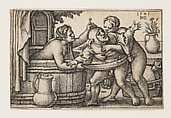Buffoon and Two Women
Sebald Beham German
Not on view
Readily recognized by his donkey-eared hat and jagged-edged tunic decorated with bells, the fool (also called a trickster, jester, or buffoon) was the quintessential medieval entertainer, whether on the street or at court. While writers such as Shakespeare cast him as a purveyor of wisdom-filled witticisms, many visual artists portrayed the fool as an uncouth lecher who makes a mockery of love.
Printmaker Sebald Beham found a successful sub-specialty in the depiction of fools, extending the character type to include both toddlers and women. His willingness to experiment with the genre resulted in creative, if explicit, engravings that show fools gleefully defecating, flaunting their privates, and cavorting with courtesans.
This image cannot be enlarged, viewed at full screen, or downloaded.


